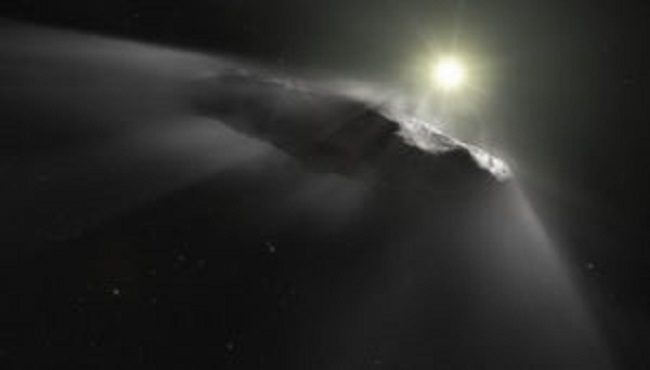Researchers have found that 'Oumuamua - the first confirmed object to enter the solar system from interstellar space - was a comet, releasing just enough gas to subtly change its course.

© ESA / Hubble / NASA / ESO / M. KornmesserAn artist's impression shows 'Oumuamua as a comet.
In October 2017 the robotic telescope
Pan-STARRS in Hawai'i detected an unusual object entering the solar system from interstellar space. In the days after the discovery, every available telescope, including Hubble, was aimed at the interloper to collect as much information as possible before it left our system. Since then, astronomers worldwide have been reviewing the observations, trying to squeeze as much knowledge as possible about the unexpected visitor.
Named 'Oumuamua ("first scout" or "first visitor" in Hawaiian), this envoy from the stars appeared to have the form of an elongated cigar - or a
flattened pancake, depending whom you ask - 800 meters (0.5 mile) long and 10 times thinner. It came
tumbling into the solar system from above the plane of the planets, only to have its path changed by the by the Sun's gravitational pull before leaving out system again, never to return.
Since its detection, astronomers have had a hard time determining what 'Oumuamua is made of. It passed very close to the Sun, within Mercury's orbit, yet it didn't show any signs of outgassing, such as a cloudlike coma or tail - signatures that would have revealed an icy composition akin to the solar system's comets. Instead, 'Oumuamua looked like an inactive, dark-red, solid chunk. Astronomers thought it was probably made of solid rock weathered by space radiation, an asteroid kicked out from a planetary system forming beyond our own.
But an international team of astronomers led by Marco Micheli (ESA SSA-NEO Coordination Centre, Italy) has found unexpected clues about 'Oumuamua's nature by looking carefully at the path it followed in and out of our system. This path didn't quite fit what was expected of a body solely influenced by the gravitational pull of the Sun, planets, and large asteroids. The team observed small deviations that pointed to the action of a non-gravitational force.
Micheli and colleagues considered several scenarios to explain the deviations, including pressure from solar radiation or magnetic interaction with the solar wind, but those options didn't quite fit the data. Instead, the motion observed is consistent with weak outgassing triggered by proximity to the Sun, as observed in other comets. The results appear in the
June 28th Nature.
Researchers calculated that the force needed to push 'Oumuamua's away from the expected path is fairly small - around 0.1% of the Sun's gravitational pull. "'Oumuamua is a small object, and just a small amount of gas is needed to generate the force we measured," Micheli says.
"The detection of the subtle non-gravitational acceleration of 'Oumuamua is exactly what you'd expect of weak outgassing towards the Sun," says Alan Fitzsimmons (Queen's University Belfast, UK), who wasn't involved in the new study. "It's a beautiful, careful analysis of the data."
But if 'Oumuamua is a comet, why didn't it appear as one? Why didn't we see evident outgassing activity as it approached the Sun? Perhaps the object lost most of its ice before leaving its home system billions of years ago, or maybe its ice slowly seeped away during the long interstellar voyage. Or, it could be that the comet has naturally low outgassing levels. Finally, it could be that the type of gas released, such as water or carbon dioxide, wasn't visible.
Fitzsimmons points to examples within our own solar system, such as comet 2P/Encke, which shows similar sublimation levels, or the near-Earth object Don Quixote, where after many years the Spitzer Space Telescope revealed a faint coma of carbon dioxide.
Deciding whether 'Oumuamua is indeed a comet rather than an asteroid doesn't just add to astronomy trivia. Current planet-forming scenarios predict that as planets grow around a star, gravitational interactions should throw large amounts of material out of the system. Most of this material would be made of icy comets. If these scenarios are correct, chances are the first interstellar object wouldn't have been rocky. If we accept that 'Oumuamua is indeed a comet, that would better fit current theoretical predictions.
Comment: How these numpties still don't get it is beyond us.
Asteroids and comets ARE THE SAME THINGS. The former just 'become' the latter when they discharge electrically due to relative electric potential difference as they pass through space.